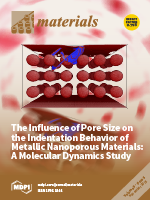A series of arene Ru(II) complexes coordinated with phenanthroimidazole derivatives, [(η
6-C
6H
6)Ru(
l)Cl]Cl(1b L =
p-ClPIP = 2-(4-Chlorophenyl)imidazole[4,5f] 1,10-phenanthroline; 2b L =
m-ClPIP = 2-(3-Chlorophenyl)imidazole[4,5f] 1,10-phenanthroline; 3b L =
p-NPIP = 2-(4-Nitrophenyl)imidazole[4,5f] 1,10-phenanthroline; 4b
[...] Read more.
A series of arene Ru(II) complexes coordinated with phenanthroimidazole derivatives, [(η
6-C
6H
6)Ru(
l)Cl]Cl(1b L =
p-ClPIP = 2-(4-Chlorophenyl)imidazole[4,5f] 1,10-phenanthroline; 2b L =
m-ClPIP = 2-(3-Chlorophenyl)imidazole[4,5f] 1,10-phenanthroline; 3b L =
p-NPIP = 2-(4-Nitrophenyl)imidazole[4,5f] 1,10-phenanthroline; 4b L =
m-NPIP = 2-(3-Nitrophenyl) imidazole [4,5f] 1,10-phenanthroline) were synthesized in yields of 89.9%–92.7% under conditions of microwave irradiation heating for 30 min to liberate four arene Ru(II) complexes (1b, 2b, 3b, 4b). The anti-tumor activity of 1b against various tumor cells was evaluated by MTT assay. The results indicated that this complex blocked the growth of human lung adenocarcinoma A549 cells with an IC
50 of 16.59 μM. Flow cytometric analysis showed that apoptosis of A549 cells was observed following treatment with 1b. Furthermore, the
in vitro DNA-binding behaviors that were confirmed by spectroscopy indicated that 1b could selectively bind and stabilize
bcl-2 G-quadruplex DNA to induce apoptosis of A549 cells. Therefore, the synthesized 1b has impressive
bcl-2 G-quadruplex DNA-binding and stabilizing activities with potential applications in cancer chemotherapy.
Full article






